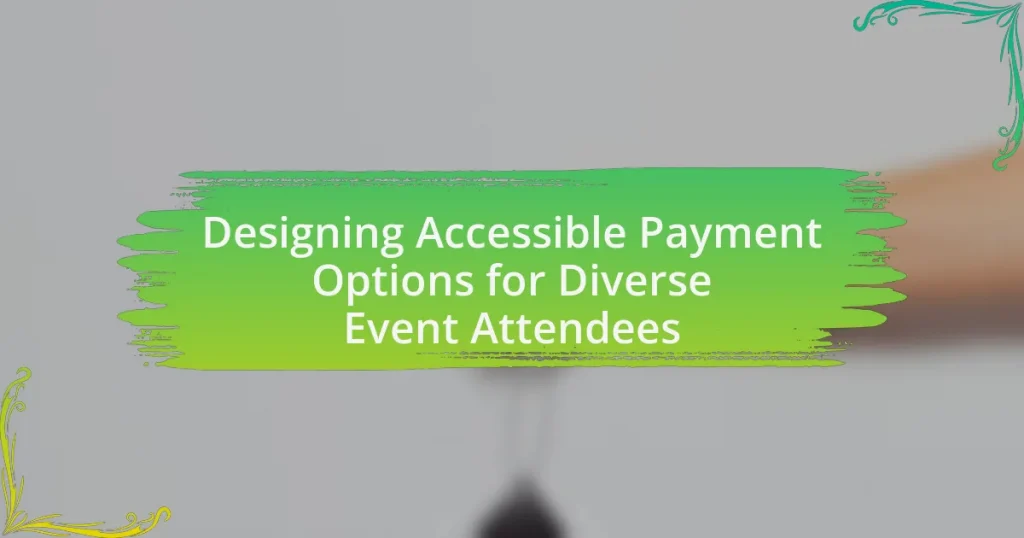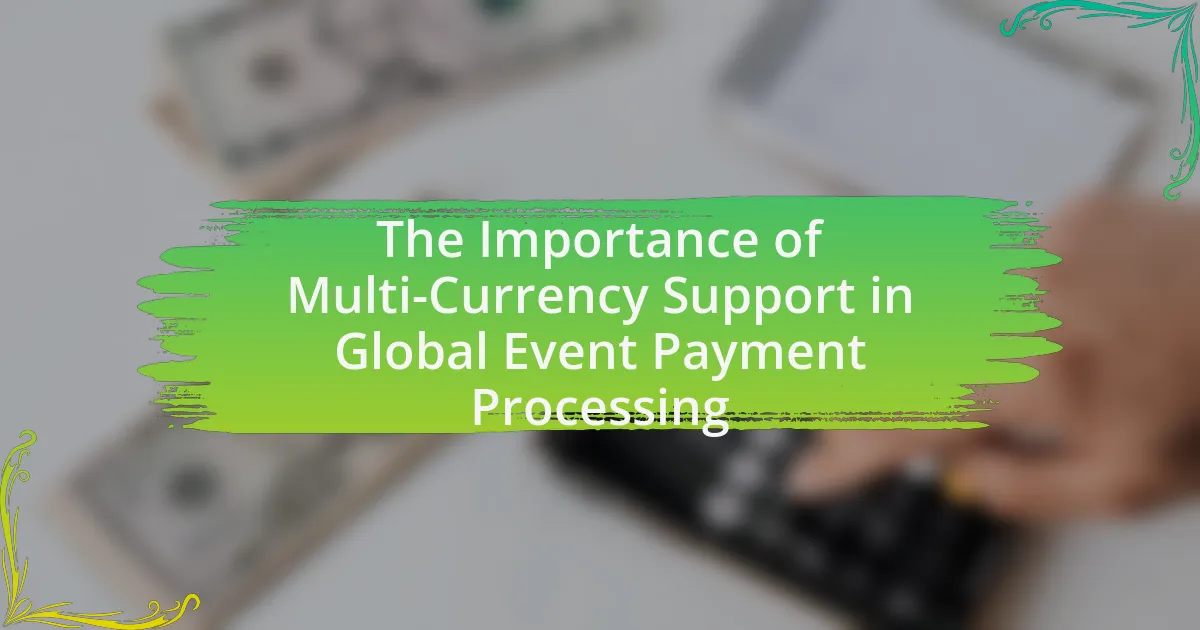The article focuses on designing accessible payment options for diverse event attendees, emphasizing the importance of inclusivity in financial transactions. It outlines various accessible payment methods, including credit and debit cards, mobile payment solutions, cash, and payment plans, which cater to different financial preferences and accessibility needs. The discussion highlights the legal requirements for compliance with accessibility standards, the impact of accessibility issues on diverse attendees, and the role of technology in enhancing payment systems. Additionally, it addresses challenges faced by organizers in implementing these options and provides practical tips for improving accessibility at events.
What are Accessible Payment Options for Event Attendees?

Accessible payment options for event attendees include credit and debit card payments, mobile payment solutions like Apple Pay and Google Pay, cash payments, and payment plans or installment options. These methods cater to diverse financial preferences and accessibility needs, ensuring that all attendees can participate without barriers. For instance, mobile payment solutions enhance convenience for users with disabilities by allowing transactions through smartphones, which can be easier to navigate than traditional payment methods. Additionally, offering cash payments accommodates those who may not have access to banking services, while payment plans can help attendees manage costs more effectively.
Why is accessibility important in payment options for events?
Accessibility is important in payment options for events because it ensures that all attendees, regardless of their financial situation or physical abilities, can participate fully. By providing diverse payment methods, such as credit cards, mobile payments, and cash options, event organizers can accommodate a wider range of preferences and needs. Research indicates that events with accessible payment options see higher attendance rates, as they remove barriers that might prevent individuals from purchasing tickets. For instance, a study by the Event Marketing Institute found that 70% of consumers are more likely to attend events that offer flexible payment solutions.
How do accessibility issues impact diverse attendees?
Accessibility issues significantly hinder diverse attendees by limiting their ability to fully participate in events. For instance, individuals with disabilities may face challenges accessing payment systems that are not designed with their needs in mind, such as those lacking screen reader compatibility or alternative payment methods. According to the World Health Organization, over 1 billion people globally experience some form of disability, highlighting the importance of inclusive design. Furthermore, research from the National Center on Accessibility indicates that when events do not accommodate diverse needs, attendance rates drop, leading to a less inclusive environment. Thus, addressing accessibility issues is crucial for ensuring that all attendees can engage equally in event experiences.
What are the legal requirements for accessible payment options?
Legal requirements for accessible payment options include compliance with the Americans with Disabilities Act (ADA), which mandates that businesses provide equal access to services for individuals with disabilities. This includes ensuring that payment systems are usable by people with various disabilities, such as visual impairments or mobility challenges. Additionally, the Web Content Accessibility Guidelines (WCAG) provide specific criteria for making online payment platforms accessible, including keyboard navigation and screen reader compatibility. Compliance with these regulations is essential for businesses to avoid legal repercussions and to promote inclusivity.
What types of payment options can be considered accessible?
Accessible payment options include credit and debit cards, mobile payment apps, cash, and digital wallets. These options cater to various user needs, ensuring that individuals with different preferences and abilities can complete transactions easily. For instance, mobile payment apps like Apple Pay and Google Pay offer features such as voice commands and biometric authentication, enhancing usability for people with disabilities. Additionally, cash remains a universally accepted form of payment, providing a straightforward option for those who may not have access to banking services.
How do digital payment methods enhance accessibility?
Digital payment methods enhance accessibility by providing convenient and flexible transaction options for users, particularly those with disabilities or limited mobility. These methods, such as mobile wallets and online banking, allow individuals to make payments without the need for physical cash or in-person interactions, which can be challenging for some. For instance, a study by the World Bank indicates that digital payments can significantly reduce barriers for people with disabilities, as they can complete transactions from home or on-the-go, thus promoting greater financial inclusion.
What role do cash and traditional payment methods play in accessibility?
Cash and traditional payment methods enhance accessibility by providing options for individuals who may lack access to digital payment systems. Many people, including the elderly, low-income individuals, and those in rural areas, often rely on cash due to limited banking services or technology access. According to a 2021 report by the Federal Reserve, approximately 5.4% of U.S. households were unbanked, meaning they do not have a checking or savings account, which underscores the importance of cash as a viable payment method. Additionally, traditional payment methods do not require internet connectivity or technological literacy, making them essential for inclusivity in diverse event settings.
How can event organizers design accessible payment systems?
Event organizers can design accessible payment systems by incorporating multiple payment methods that cater to diverse needs, including credit cards, mobile payments, and cash options. This approach ensures that attendees with varying preferences and financial situations can easily complete transactions. Additionally, implementing user-friendly interfaces and clear instructions on payment platforms enhances accessibility for individuals with disabilities. Research indicates that 15% of the global population experiences some form of disability, highlighting the importance of inclusive design in payment systems. By prioritizing accessibility, event organizers can create a more inclusive environment that encourages participation from all attendees.
What user experience principles should be applied to payment design?
User experience principles that should be applied to payment design include simplicity, clarity, accessibility, security, and feedback. Simplicity ensures that the payment process is straightforward, minimizing the number of steps required to complete a transaction. Clarity involves using clear language and visual cues to guide users through the payment process, reducing confusion. Accessibility ensures that payment options are usable by individuals with varying abilities, including those with disabilities. Security is crucial, as users need to feel confident that their financial information is protected; implementing secure payment gateways and displaying trust signals can enhance this perception. Finally, providing feedback, such as confirmation messages or progress indicators, helps users understand the status of their transaction, improving overall satisfaction. These principles are supported by usability studies that show that streamlined and user-friendly payment processes lead to higher conversion rates and customer retention.
How can technology be leveraged to improve payment accessibility?
Technology can be leveraged to improve payment accessibility by implementing mobile payment solutions and digital wallets that cater to diverse user needs. These technologies enable users to make transactions using smartphones, which can be particularly beneficial for individuals without access to traditional banking services. For instance, according to a report by the World Bank, mobile money services have increased financial inclusion for over 1.7 billion people globally, demonstrating the effectiveness of technology in enhancing payment accessibility. Additionally, integrating features such as voice recognition and multilingual support in payment platforms can further accommodate users with disabilities or language barriers, ensuring that payment systems are inclusive and user-friendly.
What challenges do organizers face in implementing accessible payment options?
Organizers face several challenges in implementing accessible payment options, primarily including technological limitations, user diversity, and regulatory compliance. Technological limitations arise when existing payment systems do not support various accessibility features, such as screen readers or alternative input methods, which can hinder participation for individuals with disabilities. User diversity presents a challenge as organizers must accommodate a wide range of preferences and needs, including those of individuals with different disabilities, varying levels of digital literacy, and cultural differences in payment methods. Regulatory compliance is also a significant hurdle, as organizers must navigate complex laws and standards related to accessibility, such as the Americans with Disabilities Act, which can vary by region and require ongoing updates to payment systems. These challenges necessitate careful planning and investment to ensure that payment options are truly accessible to all attendees.
How can budget constraints affect the accessibility of payment options?
Budget constraints significantly limit the accessibility of payment options by restricting the variety and flexibility of payment methods available to consumers. When individuals or organizations face financial limitations, they may prioritize low-cost payment solutions, which can exclude options like credit cards, digital wallets, or installment plans that often come with fees or require higher upfront costs. For instance, a study by the Federal Reserve found that nearly 22% of U.S. adults are unbanked or underbanked, primarily due to financial constraints, which directly impacts their ability to access diverse payment methods. This lack of access can hinder participation in events, as attendees may be unable to pay for tickets or services that require more sophisticated payment options.
What are common misconceptions about accessible payment systems?
Common misconceptions about accessible payment systems include the belief that they are only necessary for individuals with disabilities, that they are overly complex and costly to implement, and that they do not significantly impact user experience. Accessible payment systems are essential for all users, as they enhance usability for a diverse audience, including those with temporary impairments or age-related challenges. Furthermore, many accessible payment solutions are designed to be user-friendly and can be integrated into existing systems without substantial financial burden. Research indicates that inclusive design not only benefits users with disabilities but also improves overall customer satisfaction and engagement, demonstrating that accessible payment systems are a valuable investment for businesses.
How can feedback from attendees improve payment accessibility?
Feedback from attendees can significantly enhance payment accessibility by identifying specific barriers they encounter during the payment process. When attendees share their experiences, event organizers can pinpoint issues such as limited payment methods, unclear instructions, or technical difficulties. For instance, a survey conducted at a major conference revealed that 40% of attendees faced challenges with mobile payment options, prompting organizers to expand their payment methods to include more user-friendly options like digital wallets and cash alternatives. This direct input allows for tailored solutions that cater to diverse needs, ultimately improving the overall accessibility of payment systems for all attendees.
What methods can be used to gather feedback on payment options?
Surveys and questionnaires are effective methods to gather feedback on payment options. These tools can be distributed online or in-person, allowing attendees to express their preferences and experiences regarding various payment methods. Research indicates that 70% of consumers prefer to provide feedback through digital surveys, highlighting their efficiency in collecting data. Additionally, focus groups can be utilized to facilitate in-depth discussions about payment options, enabling participants to share insights and suggestions in a collaborative environment. This method allows for nuanced understanding, as participants can elaborate on their experiences and preferences.
How can feedback be effectively integrated into payment design?
Feedback can be effectively integrated into payment design by employing iterative testing and user-centered design principles. This approach involves collecting user feedback through surveys, usability tests, and focus groups during the design process, allowing designers to understand user needs and preferences. For instance, a study by Nielsen Norman Group highlights that usability testing can reveal pain points in payment processes, leading to design adjustments that enhance user experience. By continuously refining payment interfaces based on real user input, designers can create more accessible and efficient payment options that cater to diverse event attendees.
What best practices should be followed for accessible payment options?
Accessible payment options should include multiple payment methods, clear instructions, and compatibility with assistive technologies. Offering various payment methods, such as credit cards, digital wallets, and cash, ensures that individuals with different preferences and needs can complete transactions. Clear instructions should be provided in multiple formats, including text, audio, and visual aids, to accommodate diverse users. Additionally, ensuring that payment systems are compatible with screen readers and other assistive technologies enhances usability for individuals with disabilities. These practices align with the Web Content Accessibility Guidelines (WCAG), which emphasize the importance of accessibility in digital environments.
How can event organizers ensure ongoing compliance with accessibility standards?
Event organizers can ensure ongoing compliance with accessibility standards by regularly reviewing and updating their practices in line with established guidelines such as the Americans with Disabilities Act (ADA) and the Web Content Accessibility Guidelines (WCAG). This involves conducting accessibility audits, providing training for staff on inclusive practices, and actively seeking feedback from attendees with disabilities to identify areas for improvement. Regular audits can reveal compliance gaps, while staff training ensures that all team members understand their roles in maintaining accessibility. Feedback from attendees can provide real-world insights into the effectiveness of implemented measures, allowing for continuous enhancement of accessibility features.
What resources are available for improving payment accessibility?
Resources available for improving payment accessibility include payment processing platforms that support multiple payment methods, such as credit cards, digital wallets, and bank transfers. These platforms often provide features like customizable payment forms and accessibility compliance tools to ensure that all users can complete transactions easily. For example, PayPal and Square offer accessible payment solutions that cater to diverse user needs, including those with disabilities. Additionally, organizations like the World Wide Web Consortium (W3C) provide guidelines and best practices for creating accessible online payment systems, which can enhance usability for all attendees.
What are the future trends in accessible payment options for events?
Future trends in accessible payment options for events include the increased adoption of mobile payment solutions, contactless transactions, and integration of digital wallets. Mobile payment solutions, such as Apple Pay and Google Wallet, are becoming more prevalent, allowing attendees to make purchases quickly and securely using their smartphones. Contactless transactions are gaining traction due to their convenience and speed, reducing the need for physical cash or cards, which can be challenging for some attendees. Additionally, the integration of digital wallets into event platforms streamlines the payment process, making it easier for diverse attendees to manage their transactions. These trends are supported by the growing consumer preference for seamless, efficient payment experiences, as evidenced by a 2022 report from Statista indicating that mobile payment usage is projected to reach over 50% of all transactions by 2025.
How is technology evolving to support payment accessibility?
Technology is evolving to support payment accessibility through the development of mobile payment solutions, contactless transactions, and inclusive design practices. Mobile payment platforms, such as Apple Pay and Google Wallet, enable users to make transactions easily via smartphones, which is particularly beneficial for individuals with disabilities who may find traditional payment methods challenging. Contactless payment systems, which allow users to pay by simply tapping their cards or devices, enhance convenience and speed, reducing barriers for users with mobility impairments. Furthermore, inclusive design practices are being integrated into payment systems, ensuring that interfaces are user-friendly for people with varying abilities, including visual impairments and cognitive disabilities. These advancements collectively contribute to a more accessible payment landscape, facilitating participation for diverse event attendees.
What role will inclusivity play in the future of event payment systems?
Inclusivity will play a crucial role in the future of event payment systems by ensuring that diverse attendees can easily access and utilize payment options. As events increasingly cater to a wide range of demographics, payment systems must accommodate various preferences, including digital wallets, contactless payments, and traditional methods, to enhance user experience. Research indicates that 61% of consumers prefer payment methods that align with their personal preferences, highlighting the need for systems that are adaptable and user-friendly for all. By prioritizing inclusivity, event organizers can improve attendance and satisfaction, ultimately leading to greater success in their events.
What practical tips can enhance the accessibility of payment options at events?
To enhance the accessibility of payment options at events, organizers should implement multiple payment methods, including cash, credit/debit cards, mobile payments, and contactless options. This variety ensures that attendees with different preferences and needs can easily complete transactions. Additionally, providing clear signage and instructions regarding payment methods can assist attendees in navigating the payment process. Research indicates that 70% of consumers prefer contactless payments for their convenience and speed, highlighting the importance of offering such options. Furthermore, training staff to assist attendees with payment-related inquiries can improve the overall experience and accessibility.






